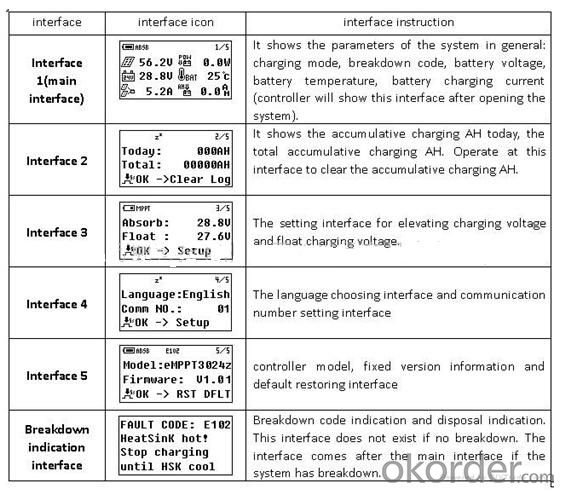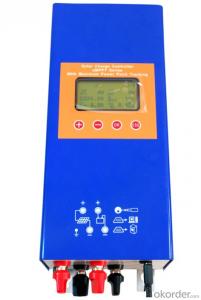Solar Controller for Tracking Maximum Power Model eMPPT 3024Z
- Loading Port:
- Shanghai
- Payment Terms:
- TT OR LC
- Min Order Qty:
- 5 unit
- Supply Capability:
- 30 unit/month
OKorder Service Pledge
OKorder Financial Service
You Might Also Like
1. Structure of Solar Controller for Tracking Maximum Power Model eMPPT 3024Z
The Solar Controller eMPPT 3024Z can be used in home system, and it benefits from DC/DC converter technique and MCU technique, which have capacity to adjust the operation spot of the solar modules so as to reach the maximum power output of the solar modules. The MCU of controller of Series eMPPT can intelligently track the operation spot of the solar modules by the algorithm MPPT, so the use ratio of solar modules can be raised and therefor the cost of the solar generating system can be reduced. Compare to the ordinary solar charging controller, eMPPT controller can in general increase the power output of the solar modules by 5% at least and 30% at most(the own characteristics of solar modules, temperature and illumination etc. have effect on how to raise the percentage of the power output ).
2. Main Features of Solar Controller for Tracking Maximum Power Model eMPPT 3024Z
Dot matrix large screen and LCD showing all parameters
Vivid icon indicating the concept of all parameters
Nice interface and clear for observation
Whole device for wall mounting type to install
3. Solar Controller for Tracking Maximum Power Model eMPPT 3024Z Images


4. Solar Controller Model for Tracking Maximum Power eMPPT 3024Z Specification
Mode | eMPPT3024Z | |
Input | Solar Module Input Voltage Scope | ≤70V |
Maximum Power Spot Tracking Voltage Scope | 12V~70V(12V) | |
24V~70V(24V) | ||
Solar Module Input Circuit | Circuit 1 | |
Output | Rated Working Voltage | 12V/24V(Automatic Identification) |
Max. Charging Current | 30A | |
Stand-by loss | ≤30mA | |
Charging Mode | Three phases for charging control(Bulk、Absorption、Float) | |
Floating Charge Voltage | 27.6V(adjustable) | |
Temperature compensation for Floating Charge Voltage | -4mV/cell/℃ | |
Absorption Charging Voltage | 28.8V(adjustable) | |
Range of Temperature measurement | -20℃~+70℃ |
5. FAQ
We have organized several common questions for our clients, which may help you sincerely:
1) How to guarantee the quality of the products?
The company is approved by the ISO9000 quality management system with its strict product quality control. The products for exportation pass the inspection of relevant foreign nations (CE, ROHS), and get high evaluation of the customers.
2) How long can we receive the product after signing Sales Confirmation?
Generally speaking, if there is enough quantity of finished products which can meet the clients’ requirement, we can manage the delivery within three to five working days according to the instruction of the payment terms in the Sales Confirmation; if the products needs some time to get ready, we will arrange the delivery as soon as possible after the manufacture.
- Q:What is the lifespan of a solar controller?
- The lifespan of a solar controller can vary depending on factors such as quality, usage, and maintenance. However, on average, a well-maintained solar controller can last anywhere between 5 to 15 years.
- Q:How does a solar controller handle variations in ambient light conditions?
- The purpose of a solar controller is to regulate and optimize the charging process of a solar panel system according to the surrounding light conditions. By utilizing advanced technology and algorithms, it efficiently manages fluctuations in light intensity and adapts the charging parameters accordingly. Monitoring the voltage and current produced by the solar panels is one of the main tasks of a solar controller. When there is ample sunlight, the controller recognizes higher voltage and current levels, indicating ideal charging conditions. Consequently, it adjusts the charging parameters to enable maximum power transfer from the panels to the battery, ensuring efficient charging. However, the solar controller must adapt as the ambient light conditions change to maintain optimal system performance. In low light situations, such as cloudy or overcast days, the controller identifies a decrease in voltage and current. In these instances, it reduces the charging parameters to prevent overcharging the battery, which could potentially cause damage or decrease its lifespan. On the other hand, during periods of high light intensity, such as sunny days, the controller detects an increase in voltage and current. To prevent overloading the battery, it modifies the charging parameters to limit the amount of power transferred, guaranteeing safe and efficient charging. Moreover, a solar controller may also incorporate additional features like temperature compensation to handle variations in ambient temperature. Since temperature affects the charging process, the controller adjusts the charging parameters to compensate for temperature fluctuations and maintain optimal charging conditions. In conclusion, a solar controller effectively manages variations in ambient light conditions by continuously monitoring and adjusting the charging parameters based on the voltage and current produced by the solar panels. This ensures efficient operation of the solar panel system, maximizes power transfer, and safeguards the battery from overcharging or other potential issues.
- Q:What is the temperature rating of a solar controller?
- The temperature rating of a solar controller typically ranges from -20°C to 60°C.
- Q:Can a solar controller be used with a battery bank?
- Yes, a solar controller can be used with a battery bank. A solar controller regulates the flow of energy from solar panels to the battery bank, ensuring that the batteries are charged efficiently and preventing overcharging or damage to the batteries.
- Q:What is the maximum current a solar controller can handle?
- The maximum current a solar controller can handle depends on its specifications and capacity. It varies from model to model, but generally, solar controllers can handle currents ranging from a few amps to several hundred amps.
- Q:What are the features of a good solar controller?
- A good solar controller should have several key features. First and foremost, it should have efficient power conversion capabilities to maximize the solar energy harvested and minimize losses. It should also have advanced charging algorithms and voltage regulation to protect the batteries from overcharging or deep discharging. Additionally, a good solar controller should have a user-friendly interface for easy monitoring and control, as well as built-in short circuit and reverse polarity protection for enhanced safety. Finally, it should be durable and weather-resistant, capable of withstanding harsh conditions and providing reliable performance over an extended period of time.
- Q:What is the typical response time of a solar controller in adjusting the charging parameters?
- The typical response time of a solar controller in adjusting the charging parameters can vary depending on the specific model and manufacturer. However, in general, most solar controllers have a response time of a few milliseconds to a few seconds. This allows them to quickly adapt to changes in solar radiation and adjust the charging parameters accordingly, ensuring efficient and optimal charging of the connected batteries.
- Q:Solar controller water level display is not correct how to do
- If not explain the control board or tube water level sensor bad, consider, for reference!
- Q:How does a solar controller handle power fluctuations in the system?
- A solar controller handles power fluctuations in the system by regulating the flow of electricity between the solar panels and the battery bank. It continuously monitors the voltage and current levels, and if there are any fluctuations, it adjusts the charging or discharging rate accordingly to maintain a stable power output. This helps to protect the system from overcharging, over-discharging, and other potential damages caused by power irregularities.
- Q:Can a solar controller be used with a solar water pumping system?
- Yes, a solar controller can be used with a solar water pumping system. A solar controller is an essential component of a solar water pumping system as it helps regulate the flow of electricity from the solar panels to the water pump. It ensures that the pump receives the right amount of power to operate efficiently and protects it from any potential damage due to overvoltage or overcurrent. The solar controller also helps optimize the performance of the system by tracking the maximum power point of the solar panels and adjusting the voltage and current accordingly. Overall, a solar controller is crucial for the proper functioning and longevity of a solar water pumping system.
1. Manufacturer Overview |
|
|---|---|
| Location | |
| Year Established | |
| Annual Output Value | |
| Main Markets | |
| Company Certifications | |
2. Manufacturer Certificates |
|
|---|---|
| a) Certification Name | |
| Range | |
| Reference | |
| Validity Period | |
3. Manufacturer Capability |
|
|---|---|
| a)Trade Capacity | |
| Nearest Port | |
| Export Percentage | |
| No.of Employees in Trade Department | |
| Language Spoken: | |
| b)Factory Information | |
| Factory Size: | |
| No. of Production Lines | |
| Contract Manufacturing | |
| Product Price Range | |
Send your message to us
Solar Controller for Tracking Maximum Power Model eMPPT 3024Z
- Loading Port:
- Shanghai
- Payment Terms:
- TT OR LC
- Min Order Qty:
- 5 unit
- Supply Capability:
- 30 unit/month
OKorder Service Pledge
OKorder Financial Service
Similar products
New products
Hot products
Related keywords





























